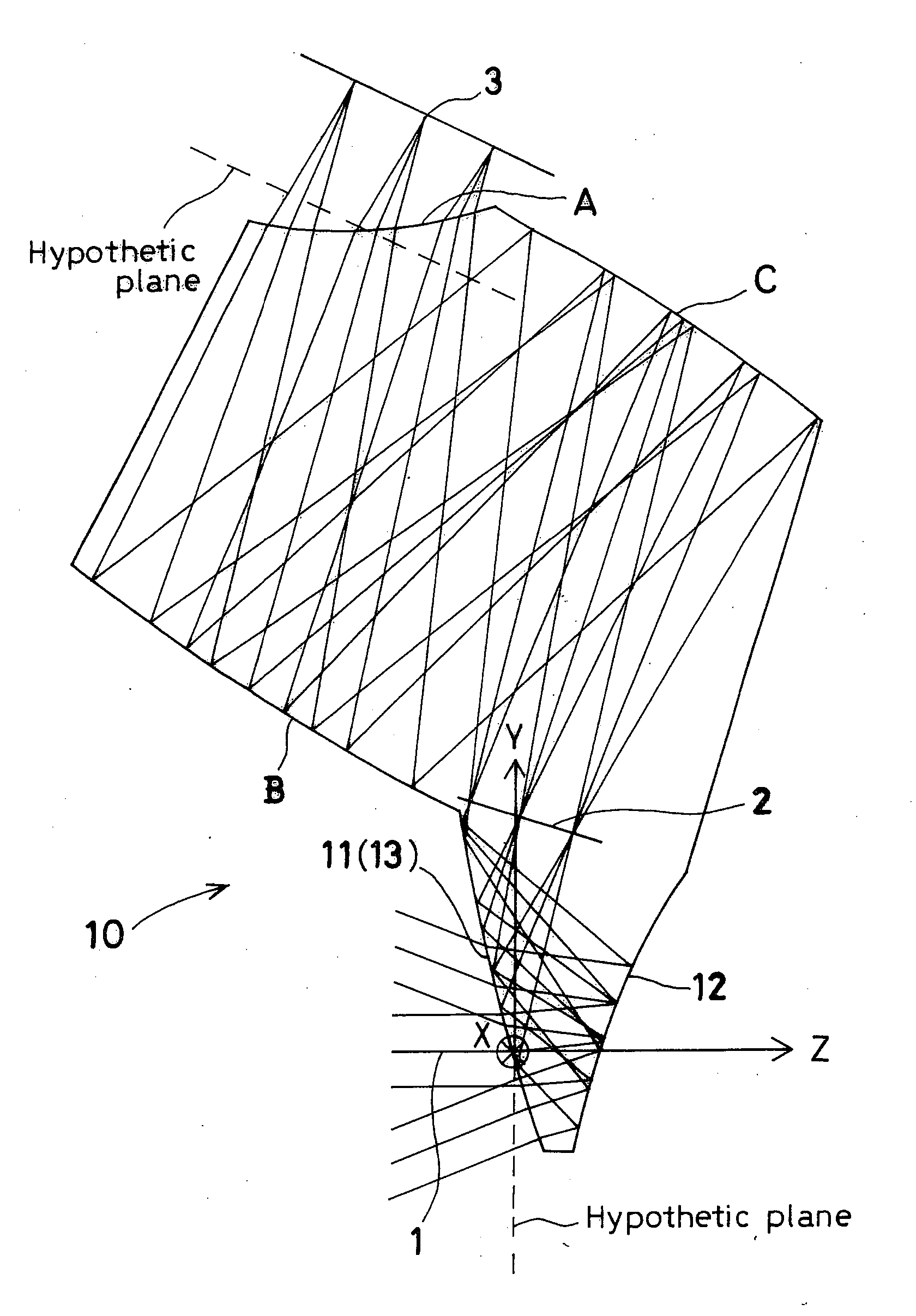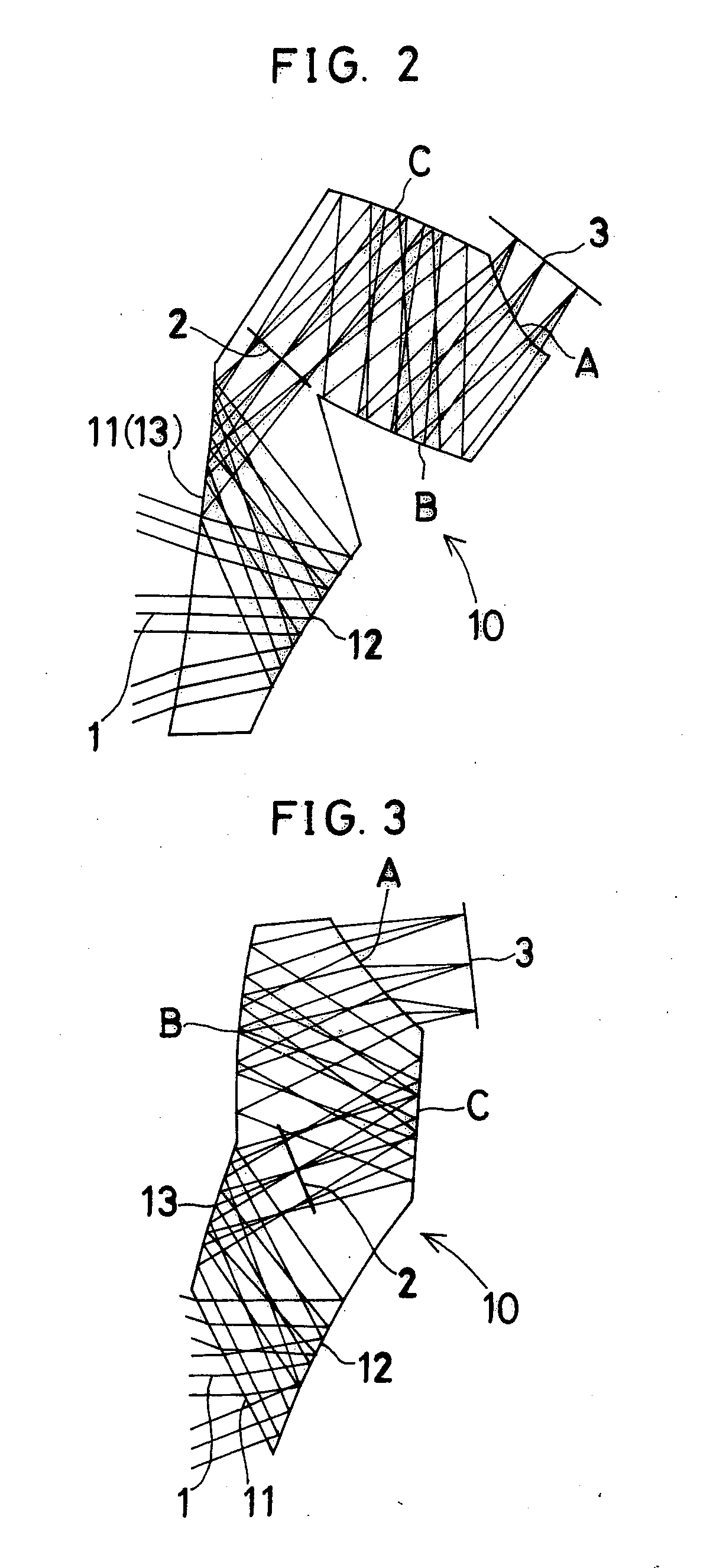Image-forming optical system
- Summary
- Abstract
- Description
- Claims
- Application Information
AI Technical Summary
Benefits of technology
Problems solved by technology
Method used
Image
Examples
examples 1 and 7
[0199]FIG. 1 is a sectional view of Example 1 taken along the YZ-plane containing the axial principal ray. The sectional view of Example 7 is similar to FIG. 1. Therefore, illustration of Example 7 is omitted. Constituent parameters of these examples will be shown later. In the constituent parameters, free-form surfaces are denoted by “FFS”, and hypothetic planes by “HRP” (Hypothetic Reference Plane). The same shall apply to the other examples.
[0200]Examples 1 and 7 each have, in order in which light passes from the object side, an object-side part of a prism 10, a stop 2, an image-side part of the prism 10, and an image plane (image-formation plane) 3. The object-side part of the prism 10 comprises an entrance surface 11 as a first surface, a first reflecting surface 12, and a second reflecting surface 13 formed from the first surface 11, which also serves as the entrance surface 11. The image-side part of the prism 10 comprises a surface C as a third reflecting surface, a surface ...
examples 2 and 8
[0202]FIG. 2 is a sectional view of Example 2 taken along the YZ-plane containing the axial principal ray. The sectional view of Example 8 is similar to FIG. 2. Therefore, illustration of Example 8 is omitted. Constituent parameters of these examples will be shown later.
[0203]Examples 2 and 8 each have, in order in which light passes from the object side, an object-side part of a prism 10, a stop 2, an image-side part of the prism 10, and an image plane (image-formation plane) 3. The object-side part of the prism 10 comprises an entrance surface 11 as a first surface, a first reflecting surface 12, and a second reflecting surface 13 formed from the first surface 11, which also serves as the entrance surface 11. The image-side part of the prism 10 comprises a surface C as a third reflecting surface, a surface B as a fourth reflecting surface, and a surface A as an exit surface. Rays from an object enter through the entrance surface 11 and are reflected successively by the first refle...
examples 3 and 9
[0205]FIG. 3 is a sectional view of Example 3 taken along the YZ-plane containing the axial principal ray. The sectional view of Example 9 is similar to FIG. 3. Therefore, illustration of Example 9 is omitted. Constituent parameters of these examples will be shown later.
[0206]Examples 3 and 9 each have, in order in which light passes from the object side, an object-side part of a prism 10, a stop 2, an image-side part of the prism 10, and an image plane (image-formation plane) 3. The object-side part of the prism 10 comprises an entrance surface 11 as a first surface, a first reflecting surface 12, and a second reflecting surface 13. The image-side part of the prism 10 comprises a surface C as a third reflecting surface, a surface B as a fourth reflecting surface, and a surface A as an exit surface. Rays from an object enter through the entrance surface 11 and are reflected successively by the first reflecting surface 12 and the second reflecting surface 13. Then, the rays pass thro...
PUM
 Login to View More
Login to View More Abstract
Description
Claims
Application Information
 Login to View More
Login to View More - R&D
- Intellectual Property
- Life Sciences
- Materials
- Tech Scout
- Unparalleled Data Quality
- Higher Quality Content
- 60% Fewer Hallucinations
Browse by: Latest US Patents, China's latest patents, Technical Efficacy Thesaurus, Application Domain, Technology Topic, Popular Technical Reports.
© 2025 PatSnap. All rights reserved.Legal|Privacy policy|Modern Slavery Act Transparency Statement|Sitemap|About US| Contact US: help@patsnap.com



